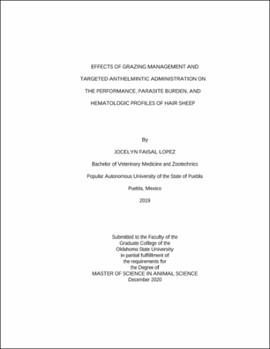| dc.contributor.advisor | Wilson, Blake | |
| dc.contributor.author | Faisal Lopez, Jocelyn | |
| dc.date.accessioned | 2021-05-25T20:42:18Z | |
| dc.date.available | 2021-05-25T20:42:18Z | |
| dc.date.issued | 2020-12 | |
| dc.identifier.uri | https://hdl.handle.net/11244/329955 | |
| dc.description.abstract | The objective of this experiment was to determine if extensively managed rotational grazing would impact the performance, fecal egg counts, and hematologic profiles of hair sheep ewes and lambs. Crossbreed hair sheep ewes and lambs were assigned to 2 experimental treatments that included a continuous (CON) grazing treatment and a rotational (RTL) grazing treatment. The experiment was conducted during the summer months from 2015 to 2019. Blood and fecal samples were collected from the ewes only and body weight (BW), body condition score (BCS), and FAMACHA^TM score (range = 1 to 5) were collected from all animals. An anthelmintic was administered if FAMACHA^TM score was ≥ 4. There was no difference in ewe (P ≥ 0.47) or lamb (P ≥ 0.57) BW between treatments at any collection period. Average BCS in late summer tended to be greater (P = 0.06) for the RTL treatment. The FAMACHA^TM score at the end of the summer regardless of yr tended to be greater (P = 0.07) for the RTL treatment. White blood cell (WBC) count was greater in early summer (P = 0.03) and tended to be greater in mid-summer (P = 0.07) for the RTL treatment. Eosinophil (EOS) count tended to be greater in early summer (P = 0.06) for the RTL treatment. Neutrophil (NEU) count for the RTL treatment tended to be greater in late spring (P = 0.10) and was greater in early summer (P < 0.02) than the CON treatment. No differences in parasite count were observed between treatments during the experiment (P ? 0.28). The percentage of lambs that score a BCS ≥ 2+ tended to be greater for the CON treatment (P = 0.07) in late summer. No difference in average FAMACHA^TM score was observed in lambs between treatments (P ≥ 0.24) at any collection. There were no differences between treatments for anthelmintic use in ewes (P ≥ 0.36) or lambs (P ≥ 0.37) at any collection. This experiment indicates that there are minimal differences between CON and RTL grazing in extensively managed hair sheep, and demonstrates that regardless of grazing system, targeted parasite management can improve herd health and decrease parasite burden. | |
| dc.format | application/pdf | |
| dc.language | en_US | |
| dc.rights | Copyright is held by the author who has granted the Oklahoma State University Library the non-exclusive right to share this material in its institutional repository. Contact Digital Library Services at lib-dls@okstate.edu or 405-744-9161 for the permission policy on the use, reproduction or distribution of this material. | |
| dc.title | Effects of grazing management and targeted anthelmintic administration on the performance, parasite burden, and hematologic profiles of hair sheep | |
| dc.contributor.committeeMember | Fitch, Gerald | |
| dc.contributor.committeeMember | Talley, Justin | |
| osu.filename | FaisalLopez_okstate_0664M_17032.pdf | |
| osu.accesstype | Open Access | |
| dc.type.genre | Thesis | |
| dc.type.material | Text | |
| dc.subject.keywords | grazing management | |
| dc.subject.keywords | hair sheep | |
| dc.subject.keywords | parasite | |
| dc.subject.keywords | performance | |
| dc.subject.keywords | rotational grazing | |
| thesis.degree.discipline | Animal Science | |
| thesis.degree.grantor | Oklahoma State University | |
